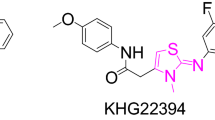Abstract
In the realm of synthetic organic chemistry, by using a one-pot sequential combination of MCR, it is possible to manufacture chemical commodities (fine chemicals, agrochemicals, and pharmaceutical substances) that enhance our quality of life while generating less waste materials and increasing economic advantages. With this motivation, using a “one-pot” method with multiple components, we present a relatively simple way to make stereoselective substitute 2H-indazole analogues for this study. Firstly, functionalised 3-bromo-4-((methylthio)methyl) derivatives were produced using DMSO as both a carbon source and a solvent, in conjunction with TMSOTf as the Lewis acid promoter. These derivatives were then utilised in the synthesis of 2-H-indazole derivatives with an up to 80% yield using t-Bu3PHBF4 as the ligand and Cs2CO3 as the base, in the presence of a Pd catalyst at 100°C in an airtight tube. The phenyl ring is endowed with an electron-releasing group situated at position C-6, which efficiently synthesises several 2-H-indazol derivatives with cost-efficient and noteworthy yields by using this method. A comparative analysis of a number of halogen derivatives was also undertaken, using a variety of solvents that were classified according to their halogen group. To confirm the structures of the synthesised target compounds, spectrometric analysis (1H NMR, 13C NMR, and LCMS) was performed.
Graphical abstract






Similar content being viewed by others
Data availability
The data underlying this study are available in the published article and its Supporting Information.
References
Cerecetto H, Gerpe A, Gonzalez M et al (2005) Pharmacological properties of indazole derivatives: recent developments. Mini Rev Med Chem 5(10):869–878. https://doi.org/10.2174/138955705774329564
Baraldi PG, Balboni G, Pavani MG et al (2001) Design, synthesis, DNA binding, and biological evaluation of water-soluble hybrid molecules containing two pyrazole analogues of the alkylating cyclopropylpyrroloindole (CPI) subunit of the antitumor agent CC-1065 and polypyrrole minor groove binders. J Med Chem 44:2536–2543. https://doi.org/10.1021/jm0108404
Koide T (1981) Influence of a chronic new potential antidepressant, 1-[3-(dimethylamino)propyl]-5-methyl-3-phenyl-1H-indazole (FS32) and its N-desmethylated compound (FS97): Treatment on monoaminergic receptor sensitivity in the rat brain. Neuropharmacology 20:285–292. https://doi.org/10.1016/0028-3908(81)90135-0
Mosti L, Menozzi G, Schenone P et al (1988) Acetic acids bearing the 1-phenyl-1H-indazole nucleus with analgesic and antiinflammatory activity. Il Farm Ed Sci 43:763–774
Li X, Chu S, Feher VA et al (2003) Structure-based design, synthesis, and antimicrobial activity of indazole-derived SAH/MTA nucleosidase inhibitors. J Med Chem 46:5663–5673. https://doi.org/10.1021/jm0302039
Park JS, Kyung AY, Kang TH et al (2007) Discovery of novel indazole-linked triazoles as antifungal agents. Bioorg Med Chem Lett 17:3486–3490
Dong J, Zhang Q, Wang Z et al (2018) Recent advances in the development of indazole-based anticancer agents. ChemMedChem 13:1490–1507. https://doi.org/10.1002/cmdc.201800253
Panchangam RL, Manickam V, Chanda K (2019) Assembly of fully substituted 2 H-indazoles catalyzed by Cu2O rhombic dodecahedra and evaluation of anticancer activity. ChemMedChem 14:262–272. https://doi.org/10.1002/cmdc.201800707
Song JJ, Yee NK (2000) A novel synthesis of 2-aryl-2 H -indazoles via a palladium-catalyzed intramolecular amination reaction. Org Lett 2:519–521. https://doi.org/10.1021/ol990409x
Halland N, Nazaré M, R’kyek O, et al (2009) A general and mild palladium-catalyzed domino reaction for the synthesis of 2 H-indazoles. Angew Chem 121:7011–7014. https://doi.org/10.1002/ange.200902323
Haag B, Peng Z, Knochel P (2009) Preparation of polyfunctional indazoles and heteroarylazo compounds using highly functionalized zinc reagents. Org Lett 11:4270–4273. https://doi.org/10.1021/ol901585k
Wu C, Fang Y, Larock RC, Shi F (2010) Synthesis of 2 H-indazoles by the [3 + 2] cycloaddition of arynes and sydnones. Org Lett 12:2234–2237. https://doi.org/10.1021/ol100586r
Stokes BJ, Vogel CV, Urnezis LK et al (2010) Intramolecular Fe(II)-catalyzed N−O or N−N bond formation from aryl azides. Org Lett 12:2884–2887. https://doi.org/10.1021/ol101040p
Kumar MR, Park A, Park N, Lee S (2011) Consecutive condensation, C-N and N–N bond formations: a copper-catalyzed one-pot three-component synthesis of 2 H-Indazole. Org Lett 13:3542–3545. https://doi.org/10.1021/ol201409j
Sun F, Feng X, Zhao X et al (2012) An efficient synthesis of 2H-indazoles via reductive cyclization of 2-nitrobenzylamines induced by low-valent titanium reagent. Tetrahedron 68:3851–3855
Genung NE, Wei L, Aspnes GE (2014) Regioselective synthesis of 2 H-indazoles using a mild, one-pot condensation-cadogan reductive cyclization. Org Lett 16:3114–3117. https://doi.org/10.1021/ol5012423
Moustafa A, Malakar C, Aljaar N et al (2013) Microwave-assisted molybdenum-catalyzed reductive cyclization of o-nitrobenzylidene amines to 2-aryl-2H-indazoles. Synlett 24:1573–1577. https://doi.org/10.1055/s-0033-1339195
Hummel JR, Ellman JA (2015) Cobalt(III)-catalyzed synthesis of indazoles and furans by c-h bond functionalization/addition/cyclization cascades. J Am Chem Soc 137:490–498. https://doi.org/10.1021/ja5116452
Aljaar N, Al-Noaimi M, Conrad J, Beifuss U (2021) Direct formation of 2-substituted 2 H-indazoles by a Pd-catalyzed reaction between 2-halobenzyl halides and arylhydrazines. J Org Chem 86:1408–1418. https://doi.org/10.1021/acs.joc.0c01923
Acknowledgements
Authors are thankful to O2h Discovery Pvt Ltd for the spectral analysis. The authors express their gratitude to Veer Narmad South Gujarat University, Surat to providing necessary lab facilities and KCG Govt. of Gujarat for Shodh fellowship.
Author information
Authors and Affiliations
Contributions
A.C in the designing of Scheme. R.P, Dr. D. G., and Prof.K.H.Chikhalia in reviewing the manuscript and spectral analysis
Corresponding author
Ethics declarations
Conflict of interest
The authors declare no conflict of interest.
Additional information
Publisher's Note
Springer Nature remains neutral with regard to jurisdictional claims in published maps and institutional affiliations.
Supplementary Information
Below is the link to the electronic supplementary material.
11030_2024_10874_MOESM1_ESM.docx
Supplementary file1 (DOCX 5173 KB) Detailed experimental procedure, spectroscopic data and copies of1H NMR and13C NMR spectra for the compounds are included in supporting Information
Rights and permissions
Springer Nature or its licensor (e.g. a society or other partner) holds exclusive rights to this article under a publishing agreement with the author(s) or other rightsholder(s); author self-archiving of the accepted manuscript version of this article is solely governed by the terms of such publishing agreement and applicable law.
About this article
Cite this article
Choudhary, A., Patel, R., Goswami, D. et al. Innovative cascade reaction for 2H-indazole derivative synthesis. Mol Divers (2024). https://doi.org/10.1007/s11030-024-10874-0
Received:
Accepted:
Published:
DOI: https://doi.org/10.1007/s11030-024-10874-0




